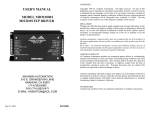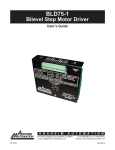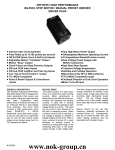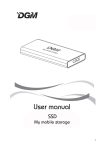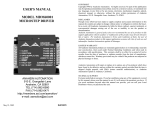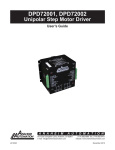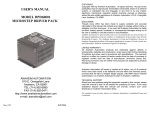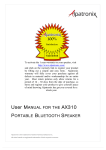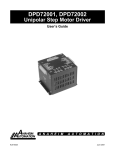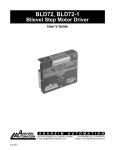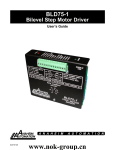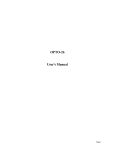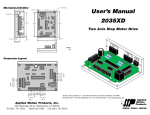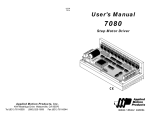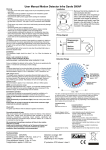Download DPFHP001 - Anaheim Automation
Transcript
DPFHP001 HIGH PERFORMANCE BILEVEL STEP MOTOR DRIVER PACK • Very High Motor Power Output • 15 Amperes/phase Maximum Operating Current • 10 Amperes/phase Standstill motor current • Internal Dual Voltage Power Supply with 500VA Transformer • High Start-Stop Speeds • Transient Voltage Suppression • Halfstep and Fullstep Operation • Bilevel Drive Operation (No RFI or EMI problems) • TTL/CMOS Compatible Inputs • Clock and Direction or Dual Clock Operation • Motor Turn-off Input • +5VDC Output GENERAL DESCRIPTION The Anaheim Automation DPFHP001 Step Motor Driver Pack is designed for motor applications that require very high power output and high start-stop step rates. Outstanding motor performance is achieved by means of an enhanced bilevel or dual-voltage drive technique. This Driver Pack contains a high performance driver board (BLHP101), a 500VA transformer, and a dual power supply. It may be used with six or eight lead, size 34 and 42 step motors whose phase current ratings range from 2 to 12.5 amperes per phase. BILEVEL DRIVE The basic function of a step motor driver is to control the motor winding currents. Motor performance is determined by how fast the driver can increase and decrease the winding currents. A rapid rise in winding current is achieved by applying a high voltage directly to a motor. This rapid rise of current is also referred to as the "kick" or operating current. When a desired current level is reached, a low voltage is applied to maintain a suitable holding current level. When a motor winding is DPFHP001 Driver Packs are shipped #L010034a turned off, a rapid decrease in winding current is achieved by routing the energy in the collapsing field back to the power supply through a high voltage path. The high voltage supply furnishes the energy necessary to maintain motor output torque at high step rates thus providing high mechanical power output. The low voltage supply provides much of the current needed at low step rates and all of the holding current. Bilevel drivers do not use high frequency switching techniques as chopper drivers do. Consequently, they do not create the EMI, RFI, and motor heating problems that are associated with chopper drivers. TRANSIENT VOLTAGE SUPPRESSION Transient Voltage Suppression (TVS) Diodes on the motor phase outputs allow for much longer motor cables to be used. Normally when using long motor cables, voltage transients and spikes are created. These transients often exceed the voltage ratings of the output phase transistors, resulting in blown transistors. The addition of the from the factory with terminal 9 TVS Diodes suppresses these transients and protects the transistors against damage. CLOCK AND DIRECTION/ CCW OPERATION DPFHP001 Driver Packs are shipped from the factory with terminals 6 and 5 assigned as CLOCK and DIRECTION inputs respectively. Pulses applied to the CLOCK input cause the motor to step in the clockwise direction if the DIRECTION input is at a logic "1" (or no connection), or in the counterclockwise direction if the DIRECTION input is at a logic "0". By setting JP1 to the "1-2" position, terminal 5 becomes the CCW (Counterclockwise Clock) input. Pulses applied to the CCW input cause the motor to step in the counterclockwise direction. Either positive or negative going pulses may be used by setting JP3 to the appropriate position. See Figure 1 and Table 1 for Jumper locations and settings. MODE SELECT/+5V OUTPUT assigned as an excitation Mode Select separated from the motor input. The Mode Select input is connections. Wiring from the used to select either halfstep orTABLE 1: Jumper Description. X=DON'T CARE driver to the motor should be fullstep motor operation. motor. Terminal 10 is the MOTOR routed away from all other wiring. Halfstep operation is generally ON/OFF Input. Hookup diagrams are shown in Figures preferred because this mode provides 2 and 3. better resolution, minimizes resonance ADJUSTING THE KICK CURRENT effects, and reduces power The kick (or operating) current level is consumption. The motor steps in CONNECTOR P1 the desired phase current level that the increments of half the natural step This 14-pin header type connector is high voltage provides each time a step angle, e.g. in 0.9 degree steps for a used for a direct connection from the is taken. The high voltage is turned off 1.8 degree step motor. In fullstep DPFHP001 to Anaheim Automation when this level is reached. The kick operation, the motor steps in 1.8 Standalone Indexers such as the current level should be set to degree steps. By setting JP2 to the "1CL2541P. The DPFHP001 powers up approximately 1.4 times the rated 2" position, terminal 9 becomes a the indexer through the 14-pin cable phase current. For example, a motor +5VDC regulated output. The driver and receives Clock, Direction, and rated at 10 amps/phase should be defaults to halfstep when the +5VDC other signals from the indexer through "kicked" to 14 amps. Table 2 shows output is used. the same cable. See Table 4. various kick current levels for corresponding phase currents. When MOTOR ON/OFF INPUT MOUNTING AND COOLING using a motor listed in Table 3, use the The MOTOR ON/OFF input can be The DPFHP001 contains an internal recommended potentiometer setting. used to turn off all four motor phases fan to create airflow through the unit. WARNING: The kick current level must (de-energize the motor) in applications Heating considerations should include be set before operating a motor. where motor detent torque is sufficient where the unit is mounted, the duty MOTOR DRIVER CONNECTIONS to maintain the load position. This cycle of operation, ambient Motor wires are connected to the driver feature can be used to reduce the load temperature, etc. Care should be pack through terminals 1, 2, 3, 12, 13, on the power supply and the heat taken so that no point on the chassis and 14. Electrical connections to dissipation in the driver circuitry and exceeds 60 degrees Celsius. control inputs should be kept physically #L010034a JUMPER DESCRIPTION JP1 JP2 JP3 TERMINAL 5 = DIRECTION 2-3 X X TERMINAL 5 = CCW 1-2 X X TERMINAL 9 = HS/FS X 2-3 X TERMINAL 9 = +5VDC OUTPUT X 1-2 X POSITIVE GOING CLOCK INPUTS X X 2-3 NEGATIVE GOING CLOCK INPUTS X X 1-2 2-3 2-3 1-2 STANDARD PRODUCT (READY TO SHIP) #L010034a SPECIFICATIONS: POWER REQUIREMENTS 105 VAC to 125 VAC for DPFHP001 210 VAC to 250 VAC for DPFHP001x220 CONTROL INPUTS (Terminals 5,6,9,10): Logic "0": 0 to 0.8 VDC. Logic "1": 3.5 to 5 VDC. CLOCK Input: (Terminal 6) This input is either pulled down (for positive going pulses) or up (for negative going pulses) through a 10k ohm resistor ( set by JP3). A pulse width of 15 microseconds minimum is required to step the motor. The maximum control pulse rate is limited by motor performance. DIRECTION/CCW Input: (Terminal 5) When programmed as DIRECTION input (set by JP1), this input is internally pulled up to +5VDC through a 10k ohm resistor. When a logic "1" (or no connection) is applied, the motor will step in the clockwise direction when pulses are applied to the CLOCK input. Similarly, when a logic "0" is applied, the motor will step in the counterclockwise direction when pulses are applied to the CLOCK input. When programmed as CCW input, the motor will step in the counterclockwise direction when pulses are applied to this input (pulse requirement is same as for CLOCK input). MODE SELECT/+5VDC OUTPUT: (Terminal 9) When programmed as Mode Select Input (set by JP2), this terminal is internally pulled up to +5VDC through a 10k ohm resistor. When a logic "1" (or no connection) is applied, the motor will operate in halfstep mode. When a logic "0" is applied, the motor will operate in fullstep mode. When this terminal is programmed as +5VDC Output, up to 500mA may be used to power up external circuitry. The driver defaults to halfstep when the +5VDC output is used. MOTOR ON/OFF INPUT: (Terminal 10) This terminal is internally pulled up to +5VDC through a 10k ohm resistor. When a logic "1" (or no connection) is applied, the driver phase outputs are enabled and the motor is energized. When a logic "0" is applied, the driver phase outputs are disabled and the motor is de-energized. MOTOR PHASE OUTPUTS: (Terminals 1,2,13,14) These outputs can sink a peak of 15 Amperes or sink 10 Amperes continuously and stand-off 250 VDC maximum. MOTOR COMMON OUTPUTS: (Terminals 3,12) These outputs can source a peak current of 15 Amperes, or source 10 Amperes continuously. AMBIENT TEMPERATURE: 0 to 50 degrees Celsius. SHIPPING WEIGHT: 15 pounds #L010034a Rated Motor Phase Current KICK CURRENT 1.4 - 2.4 2.0 - 3.4 2.4 - 3.3 3.4 - 4.6 3.3 - 4.3 4.6 - 6.0 4.3 - 5.4 6.0 - 7.5 5.4 - 6.3 7.5 - 8.8 6.3 - 7.2 8.8 - 10.1 7.2 - 8.1 10.1 - 11.4 8.1 - 8.9 11.4 - 12.5 8.9 - 9.6 12.5 - 13.5 9.6 - 12.5 13.5 - 15.0 Table 2: Potentiometer Settings for Kick Current. P1 Pin 1 Description N/C 2 N/C 3 +12V UNREG. 4 N/C 5 DIRECTION 6 MOTOR ON/OFF 7 HS/FS 8 N/C 9 N/C 10 CLOCK 11 0VDC 12 N/C 13 0VDC 14 N/C TABLE 4: 14-Pin Header for Indexer Interfacing. #L010034a AA MOTOR HOLDING CURRENT KICK CURRENT 34D106 1.95 - 3.00 4.20 34D109 3.12 - 4.80 6.72 34D207 2.28 - 3.50 4.90 34D209 3.00 - 4.60 6.44 34D213 4.23 - 6.50 9.10 34D307 2.28 - 3.50 4.90 34D311 3.58 - 5.50 7.70 34D314 4.55 - 7.00 9.80 42D112 3.97 - 6.10 8.54 42D119 6.18 - 9.50 13.3 42D212 3.97 - 6.10 8.54 42D219 5.98 - 9.20 12.88 42D225 8.25 - 10.00 15.00 TABLE 3 Holding Current and Kick Current Settings for AA Motors. TORQUE/SPEED CURVES #L010034a







